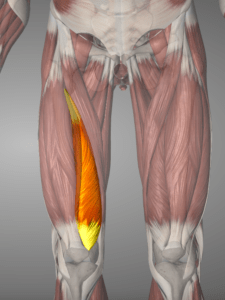Osteoarthritis, a condition characterized by the degeneration of joint cartilage and underlying bone, is a significant health concern, particularly in weight-bearing joints like the knee. Recent research, such as the study titled “Muscle weakness is associated with non-contractile muscle tissue of the vastus medialis muscle in knee osteoarthritis” by Josien C. van den Noort and colleagues, sheds light on a specific aspect linking osteoarthritis and muscle weakness. In this blog, we’ll explore the findings of this study and understand the implications for individuals grappling with knee osteoarthritis.

The Vastus Medialis Oblique (VMO): A Key Player
The vastus medialis oblique, a muscle located on the inner side of the thigh, plays a crucial role in knee stability and alignment. Its proper function is integral to the mechanics of the knee joint, especially during activities like walking, running, and climbing stairs. Josien C. van den Noort’s study explores the intricate connection between the weakness in the Vastus Medialis Oblique (VMO) and the existence of non-contractile muscle tissue in individuals experiencing knee osteoarthritis.
Findings of the Study:
The research suggests a noteworthy association between muscle weakness in the VMO and the presence of non-contractile muscle tissue, particularly in the context of knee osteoarthritis. This non-contractile tissue is indicative of muscle degeneration or atrophy, a common occurrence in individuals with chronic joint conditions.
Implications for Knee Osteoarthritis Management:
- Targeted Rehabilitation: Understanding the correlation between VMO weakness and osteoarthritis highlights the importance of targeted rehabilitation. Strengthening exercises specifically focused on the VMO can potentially contribute to improved knee function and reduced symptoms.
- Early Intervention: Identifying muscle weakness in the early stages of knee osteoarthritis becomes crucial. Early intervention, including tailored exercise programs, can potentially slow down or mitigate the progression of muscle degeneration.
- Comprehensive Treatment Plans: Healthcare professionals managing knee osteoarthritis may now consider incorporating assessments of VMO strength into comprehensive treatment plans. This allows for a more individualized approach to rehabilitation.
Strategies for Strengthening the Vastus Medialis Oblique:
- Quad Sets: Isometric contractions focusing on the VMO can be performed by tightening the muscles at the front of the thigh while keeping the leg straight.
- Mini Squats: Controlled mini squats engage the VMO and promote overall quadriceps strength.
- Terminal Knee Extensions: This exercise specifically targets the VMO by extending the knee against resistance in a seated position.
- Lateral Step-Ups: Incorporating lateral step-ups into the exercise routine challenges the VMO while enhancing overall lower limb strength.
As we uncover the link between osteoarthritis and VMO weakness, the importance of targeted exercises for this specific muscle comes to the forefront. For individuals dealing with knee osteoarthritis, consulting with healthcare professionals for a tailored rehabilitation plan is paramount. By addressing muscle weaknesses early on, we empower ourselves to potentially improve joint function, alleviate symptoms, and enhance overall quality of life in the face of osteoarthritis.

